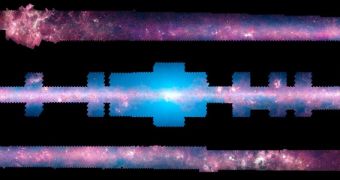Officials with the American space agency presented an amazing new image mosaic on Thursday, March 20, during the TEDActive 2014 Conference held in Vancouver, Canada. The zoomable dataset is a 360-degree panorama of the Milky Way, created by combining more than 2 million infrared images of the galaxy. The photos were collected by the NASA Spitzer Space Telescope over the past 10 years.
The entire image is uploaded here and can be viewed using a good Internet connection. Users can easily zoom in and out over areas of interest and can adjust a slider controlling the overlay between the new Spitzer panorama and background infrared image of the Milky Way. This makes it easier to see the context in which the 2 million images were taken.
Imaging specialist Robert Hurt, who holds an appointment with the NASA Spitzer Science Center (SSC) in Pasadena, California, argues that “if we actually printed this out, we'd need a billboard as big as the Rose Bowl Stadium to display it. Instead we’ve created a digital viewer that anyone, even astronomers, can use.”
In order to be able to load the vast panorama, the Spitzer team that created the new product decided to use the WorldWide Telescope visualization platform developed by Microsoft. This software enables the accurate and timely display of the 20-gigapixel panorama, which covers an estimated 3 percent of the night sky. Most of the 2 million IR images cover a narrow band along the plane of the galaxy.
According to yesterday's presentation, many of the images included in this mosaic were taken from the Galactic Legacy Mid-Plane Survey Extraordinaire (GLIMPSE) project. During its decade in space, Spitzer has spent no less than 172 days (a total of 4,142 hours) imaging the plane of the Milky Way at infrared wavelengths. This panorama is the first coherent effort to stitch all of these photos together.
“Spitzer is helping us determine where the edge of the galaxy lies. We are mapping the placement of the spiral arms and tracing the shape of the galaxy,” says the co-leader of the GLIMPSE science team, Ed Churchwell, who holds an appointment with the University of Wisconsin-Madison (UWM).
“There are a whole lot more lower-mass stars seen now with Spitzer on a large scale, allowing for a grand study. Spitzer is sensitive enough to pick these up and light up the entire ‘countryside’ with star formation,” adds UWM researcher and GLIMPSE team co-leader, Barbara Whitney.
The last major panorama astronomers assembled from Spitzer data covered 130 degrees of our galaxy and focused on the hub of the Milky Way. The new mosaic will help NASA guide the eyes of its upcoming James Webb Space Telescope (JWST) when it launches, beyond 2018. The JWST will attempt to create its own 360º view of the galaxy, at optical wavelengths.

 14 DAY TRIAL //
14 DAY TRIAL //